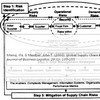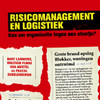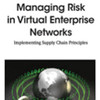 More than 500-page heavy and laden with real-life examples and thoroughly calculated details, Designing and Managing the Supply Chain by David Simchi-Levi, Philip M Kaminsky and Edith Simchi-Levi this an excellent textbook that will teach you much more than just supply chain design and management. This book takes on a unique approach, and teaches you how the supply chain is an integrated part of any business, not something added to it to make the business work. The supply chain is the business; if it is not properly designed and managed, there is no business. Thus, this book is more than just about supply chain management, it is about business management in a wider sense. Unfortunately though, supply chain risk does not feature very prominently in this book.
More than 500-page heavy and laden with real-life examples and thoroughly calculated details, Designing and Managing the Supply Chain by David Simchi-Levi, Philip M Kaminsky and Edith Simchi-Levi this an excellent textbook that will teach you much more than just supply chain design and management. This book takes on a unique approach, and teaches you how the supply chain is an integrated part of any business, not something added to it to make the business work. The supply chain is the business; if it is not properly designed and managed, there is no business. Thus, this book is more than just about supply chain management, it is about business management in a wider sense. Unfortunately though, supply chain risk does not feature very prominently in this book.
Unique
Normally, in most supply chain books I have seen, e.g. Logistics Management and Strategy, there is ample ink devoted to theories and concepts with a couple of examples thrown in next to illustrative and basic generic figures. They teach you concepts, but not how to run your own supply chain.
Not so here. Each chapter is based around one or several anecdotes of real life examples that are meant to illustrate certain concepts, e.g. sourcing strategies, and everything in the chapter evolves around that example. It is impossible to just read this book from beginning to end and get a sense of supply chain concepts and issues, you really have to follow through and do the math in the examples, let alone the questions for discussion at the end of each chapter.
Seen from a manager’s or CEO’s perspective, the reader is invited to take part in the solution of the problem in the supply chain of said manager, by trying to understand how that particular supply chain works, and by calculating what to do next. Some of the anecdotes even read like suspense novels, and on occasion I really felt like wanting to skip the math and flip to the end to see how the story went…but then I would miss the point of how the problem was actually solved.
Not for the faint-hearted
Mind you, this is a textbook aimed specifically at graduate students, and while the undergraduate student may be overwhelmed by the sheer volume of information in this book, a graduate student should not. It IS NOT a book for learning by reading and remembering. It IS a book for learning by doing, i.e. taking notes, looking up references, structuring your notes and calculating on your own.
It is perhaps not so useful as a quick reference book suited for a busy supply chain executive. However, it may serve well as a reference for a supply chain analyst preparing a report for the busy executive.
Book Highlights
With 500+ pages, as already mentioned, and with case examples drawn from a wide range of industries, this is a very comprehensive book, covering in extensive detail almost every nook and cranny of supply chain management:
- Inventory Management and Risk Pooling
- Network Planning
- Supply Contracts
- The Value of Information
- Supply Chain Integration
- Distribution Strategies
- Strategic Alliances
- Procurement and Outsourcing
- Global Logistics and Risk Management
- Coordinated Product and Supply chain Design
- Customer Value
- Smart Pricing
- Information Technology and Business Processes
- Technology Standards
Each chapter begins with a case that thoroughly discusses the topic of the chapter, it ends with a summary and questions for discussion. Often there is a second or even a third case after this, providing yet further how-to knowledge in supply chain management.
Inventory Management and Risk Pooling
This chapter focuses on an essential task of supply chain management, namely matching supply with demand, by properly managing inventory. Case examples are Steel Works Inc, a manufacturer of custom and specialty use steels, and Sport Obermeyer, a ski clothing manufacturer. Topics covered include inventory holding and setup cost, lead time variability and forecast demand. The chapter discusses the three rules of inventory management,
- forecast demand is always wrong,
- the longer the forecast horizon, the worse is the forecast,
- aggregate demand information is always more accurate than disaggregate data,
and how risk pooling is one strategy that enables a lower inventory level without affecting the service level.
Related post: In The role of elasticity in supply chain performance Hull (2005) develops a model that describes the performance of supply chains based on their elasticities of supply and demand.
Network Planning
This chapter looks at what is the best or most cost-effective strategy for locating manufacturing, warehousing and distribution facilities and how to link these with the right logistics setup. Case examples are the BIS Corporation, a manufacturer of paints, ElecComp Inc., a contract manufacturer of of circuit boards and high-tech parts, and H.C.Starck Inc., a manufacturer of metallurgical products. Among others, topics covered are
- Network design
- Inventory positioning
- Resource allocation
and the chapter describes how to find the best match that considers the entire network and takes into account production, warehousing, transportation, inventory costs and service level requirements.
Related post: In Reliability Models for Facility Location: The Expected Failure Cost Case, Snyder and Daskin (2005) describe how to locate facilities such that disruption cost is minimized.
Supply Contracts
This chapter deals with with supplier relations as they are formed by contracts. American Tool Works, a leading manufacturer of high quality power hand tools is used as a case example. Topics covered are the pros and cons of the various types of contracts and when to use which type of contract, such as
- Buy-Back,
- Revenue-Sharing,
- Quantity-Flexibility,
- Sales Rebate,
- Global Optimization,
- Pay-Back,
- Cost-Sharing,
- Capacity-Reservation,
- Advanced-Purchase,
- Long-term,
- Flexible-Option,
- Spot Purchase, and
- Portfolio Contracts.
Some contracts are covered in extensive detail, while others are more cursory described, presumable reflecting which that is most used.
Related post: Not as comprehensive, but some of the same issues are covered in Giertz (1999) in How to secure your supply chain, a Swedish handbook in supply chain risk and business continuity management.
The Value of Information
Case examples in this chapter are Italian pasta manufacturer Barilla and sports apparel maker Reebok. The so-called bullwhip effect is at the core of this chapter, which looks at certain techniques that can be used to counteract the bullwhip effect, first and foremost information sharing and centralized demand information. The bullwhip effect is also used to illustrate that a supply chain goes through various stages where conflicting objectives can be met through certain trade-offs that are made possible if sufficient and accurate information on supply and demand is at hand:
- Lot Size Inventory Trade-Off: Smaller lots may be more expensive to manufacture, but lead to less inventory, shorter lead times and a more variable supply to meet variable demand.
- Inventory-Transportation Cost Trade-Off: While shipping large quantities is cheaper than shipping small quantities, shipping Less-Than-Truckload may satisfy immediate demand, but consolidating loads will brings the overall cost down.
- Product Variety-Inventory Cost Trade-Off: Increasing product variety increased manufacturing cost, as well as transportation and warehousing cost, if all warehouses need to stock all products. This can be countered by delayed differentiation, where generic product modules are assembled at warehouses and distribution centers rather than at the factory, thus reducing inventory variability.
- Cost-Customer Service Trade-Off: Reducing inventories, manufacturing costs and transportation costs may come at the expense of customer service level. However, advanced information services coupled with advanced manufacturing and distribution can be used to give customers a service they haven’t been able to realize before, by delivering highly personalized goods that customer may be willing to wait for longer than what they can buy off the shelf.
Related post: Faisal, Banwet & Shankar (2007) Information risks management in supply chains: an assessment and mitigation address that while openness, partnering, trust and particularly sharing of information has often been cited as one way to reduce supply chain risk, it also comes with its own set of risks.
Supply Chain Integration
Using computer manufacturer Dell and chipmaker Cisco as the main case examples, this chapter looks at the different types of supply chains for different types of commodities, in particular
- Push
- Pull
- Push-Pull
and how this effects the different production and distribution decisions, how push and pull link up with economies of scale and demand uncertainty, and how push and pull link up with lead time and demand uncertainty.
Related post: Christopher, Peck, & Towill (2006) A taxonomy for selecting global supply chain strategies, use a slight similar approach when they discuss lean, agile and leagile supply chains.
Distribution Strategies
What could be a better case example for discussing distribution decision strategies than Amazon.com? I can’t think of a better case and the book spends not less than 21 pages on this. In addition, this chapter discusses the differences between
- Direct shipment
- Intermediate inventory storage point
- Traditional warehousing
- Cross-Docking
- Transshipment
and how these decisions depend on the nature and characteristics of costs, products, and customers.
Related post: Naim, M., Aryee, G., & Potter, A. (2010) Determining a logistics provider’s flexibility is a good source for choosing the right logistics provider for the desired distribution strategy.
Strategic Alliances
The title of this chapter was a bit misleading to me as it not about the strategic alliances that are built in boardrooms, but the alliances and how they affect the shop floors. The case example is Costco & Kimberley-Clark, with the latter in charge of stocking the shelves of the former, thus being able to match demand with production, while the former has lowered prices and increased customer satisfaction. In particular, this chapter deals with
- Third-party logistics, 3PL,
- Retailer-supplier partnership, RSP, and
- Distributor integration, DI.
While I agree that the three above can take the form of an strategic alliance, employing them per se does not necessarily make it a strategic alliance.
Related post: Das & Teng (2001) Trust, Control and Risk in Strategic Alliances propose a new integrated framework for these three constructs in the context of strategic alliances, essentially asking: Can strategic alliances really work?
Procurement and Outsourcing
This chapter considers the benefits and risks of procurement and outsourcing. Spania-based high-end fashion and clothing retailer Zara serves as the case example, along with Solectron, an electronics manufacturer. The positive sides of outsourcing are listed as
- Economies of scale
- Risk pooling
- Reduce capital investment
- Focus on core competence
- Increased flexibility
while the negative sides are
- Loss of competitive knowledge
- Conflicting objectives between buyer and supplier
Related post: Treleven and Schweikhart (1988) A risk/benefit analysis of sourcing strategies: Single vs. multiple sourcing was among the first papers to examine the costs and benefits of single versus multiple sourcing strategies.
Global Logistics and Risk Management
This chapter focuses on global supply chains specifically, which I find a bit interesting, as most of the case examples already mentioned are global. Wal-Mart’s multinational efforts serves as a case example here, so perhaps a global supply chain in the sense of this book is in fact a multinational supply chain operated by the same company? Issues that such supply chains must account for are
- Global market forces,
- Technological forces,
- Global cost forces, and
- Political and economical forces.
Related post: While there obviously are many that could be cited here, Manuj and Mentzer (2008) Global Supply Chain Risk Management Strategies is the one that first comes to mind.
Coordinated Product and Supply Chain Design
This chapter begins with the case of Hewlett-Packard and their DeskJet printer supply chain, clearly showing how the development chain and supply chain are inextricably linked in that the former affects the latter, and may even hamper the flow of the supply chain. Products, albeit primarily designed for customer satisfaction, should nonetheless also be designed for logistics satisfaction. Issued discussed include
- Modular products
- Modular processes
- Part standardization
- Process standardization
In addition, supplier integration can play a major role in product design, and can take place along a spectrum of integration:
- None
- White box – informal, buyer consults supplier
- Gray box – joint development in collaborative buyer-supplier teams
- Black box – supplier designs product based on buyer’s interface requirements
Related post: Khan, Christopher, & Burnes (2008) The impact of product design on supply chain risk: a case study show how UK-based Mark & Spencer learned its lesson the hard way, but has bounced back after it realized how crucial product design is in supply chain risk.
Customer Value
The essence of this chapter is that excellence in supply chain management translates into customer value in many dimensions, from availability and selection to influencing the price at which a product can be sold. Issues realted to customer value are
- Conformance to requirements, giving customer what he wants and needs
- Product selection, proliferation of customer options
- Price and brand, matching asking prices with brand reputation
- Value-added services, e.g. support and maintenance (free of charge)
- Relationships and experiences, connecting customer and firm
- Achieving excellence, target one attribute and differentiate yourself from competitors
Smart Pricing
This chapter tells the story of how smart pricing can increase or even decrease demand, depending on which you may prefer (if profit margins on a certain product are low, you may in fact prefer the latter). The case is Starbuck’s and how they simply do not list available drinks because they don’t generate much profit, although you may ask for it and you will get it. Or why does the value range at supermarket have such an ugly packaging? Of course, to make you buy the higher priced and more profitable high-end products.
Smart pricing involves issues such as
- Group pricing, discounts for certain groups of customers
- Channel pricing, different prices for different channels
- Regional pricing, exploiting price sensitiveness in different locations
- Time-base differentiation, different price for different delivery times
- Product versioning, different branding of what is essentially the same product
- Coupons and rebates, where the coupon is meant to be a hurdle, not an incentive
However, if customers feel that they have been unfairly treated or outsmarted by these smart prices, it may ultimately hurt the business.
Related post: In Tang, C. (2006) Robust strategies for mitigating supply chain disruptions smart pricing is used by Dell to avert the effect of a supply chain disruption, by discounting available products and marking up items with little or no inventory, thus channeling customers towards certain items.
Information Technology and Business Processes
This chapter takes a close look at how changes in IT change business processes which ultimately change supply chain management decisions. Appliances manufacturer Whirlpool and convenience store chain 7Eleven are case examples here, showing how companies that apply business processes and technology properly outperform their peers.
Technology Standards
This last chapter looks at two technologies that are likely to become major future standards, SOA and RFID. While SOA provides the backbone for building more adaptable systems, the implementation of RFID will allow for real time tracking of products. The case example is Pacorini, and Italy-based logistics provider, who put in place a service-oriented architecture (SOA) that integrates online and offline processes.
Critique
This book is for graduate students, and for that audience it is an excellent book. Interestingly, if you read the reviews at amazon.com, it doesn’t fall in such good soil. Most reviewers are quite negative, perhaps for lack of appreciation of the subject?
One reviewer said “…Also, every time there is a new term they write [see 101] or [96] etc. I am assuming they mean page numbers by that? But so far I was not successful in finding these mysterious terms or any meaningful explanation for them. I always end up searching the terms through Google…” Seriously, you can not have read many books in your career if that is supposed to be a turn-off…those numbers simply refer to the same number in the list of references in the Bibliography at the end of the book. That is a very common way of referencing that I think every student should be familiar with.
If there is one negative side to this book, it is that it is overly long in some parts, while other parts are kept very brief. I would have loved to see a separate chapter on supply chain risk, and also a chapter on reverse logistics and sustainable supply chains, and perhaps even a bit of corporate social responsibility. That would have truly made this a complete supply chain management book, That said, a fourth edition of this book is currently in progress, so perhaps it will be included there?
Conclusion
If I were an MBA student this book would be one of my favorite companions. Yes, it’s not an easy read, but it’s a rewarding read, when you do the follow-up as you should. If you’re expecting a Supply Chain 101 book that serves you everything in teaspoon by teaspoon, as we say in Norway, this is not the book for you. Personally, I love this book; it is perhaps more than I ever wanted to and ever needed to know about supply chains, but that is a good thing, meaning that I will not grow tired of it.
Reference
Simchi-Levi, D. ; Kaminsky, P. and Simchi-Levi, E. (2007) Designing and Managing the Supply Chain. New York: McGraw-Hill.
Author links
- mit.edu: David Simchi-Levi
- berkeley.edu: Philip M. Kaminsky
- linkedin.com: Edith Simchi-Levi
Buy this book
- amazon.com: Designing and Managing the Supply Chain
Related posts
- husdal.com: Operations Rules
- husdal.com: Supply Chain as Strategic Asset












